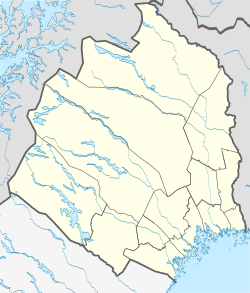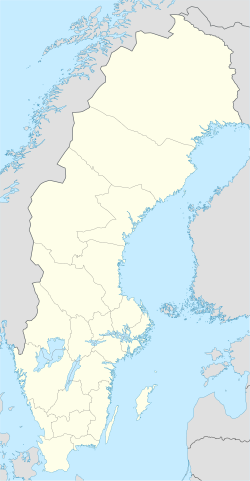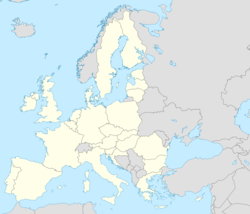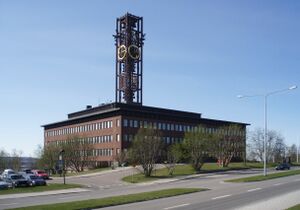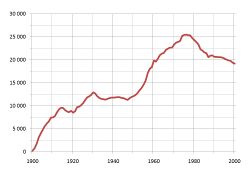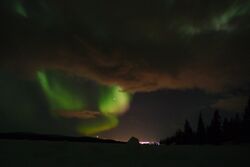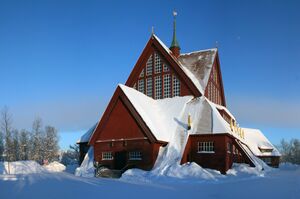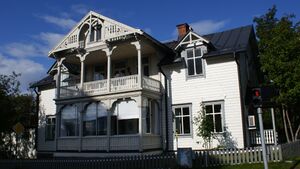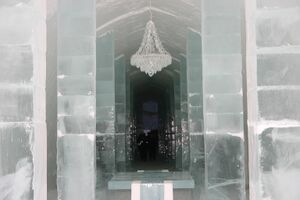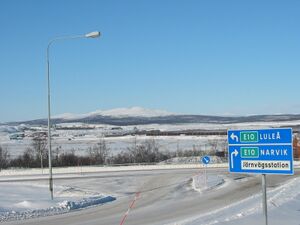كيرونا
Kiruna (سويدية)
| |
|---|---|
| كيرونا | |
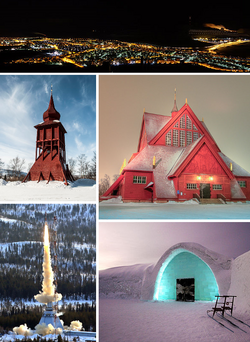 في اتجاه عقارب الساعة من الأعلى: أفق كيرونا ليلاً، كنيسة كيرونا، فندق الجليد في يوكاسيرڤي، إطلاق صاروخ في إسرانگى، برج الجرس في كنيسة كيرونا. | |
| الإحداثيات: 67°50′56″N 20°18′10″E / 67.84889°N 20.30278°E | |
| البلد | السويد |
| المركز | لاپلاند |
| المقاطعة | مقاطعة نوربوتن |
| البلدية | بلدية كيرونا |
| City plan adopted | 27 أبريل 1900 |
| Charter | 1 يناير 1948 |
| المساحة | |
| • الإجمالي | 16٫53 كم² (6٫38 ميل²) |
| التعداد (30 سبتمبر 2019)[1] | |
| • الإجمالي | 22٬906 |
| • الكثافة | 1٬098/km2 (2٬840/sq mi) |
| منطقة التوقيت | UTC+1 (CET) |
| • الصيف (التوقيت الصيفي) | UTC+2 (CEST) |
| الموقع الإلكتروني | kiruna.se |
كيرونا (Kiruna؛[2] سامي شمالية: Giron; فنلندية: Kiiruna، هي مدينة تقع في أقصى شمال السويد، في مديرية لاپلاند. بحسب تعداد 2016 بلغ عدد سكانها 17002 نسمة[3] وهي مقر بلدية كيرونا (عدد السكان: 23167 بحسب تعداد عام 2016)[4] في مقاطعة نوربوتن. وقد بُنيت المدينة في الأصل في التسعينيات لخدمة منجم كيرونا.
وفي الستينيات، أُنشئ في المدينة مركز إسرنج الفضائي.[5] كما يقع في كيرونا معهد فيزياء الفضاء[6] وقسم علوم الفضاء التابع لجامعة لوليو للتكنولوجيا.[7]
التاريخ
الأصول
تشير الاكتشافات الأثرية إلى أن المنطقة المحيطة بكيرونا مأهولة بالسكان منذ 6000 عام على الأقل.
عُرف تواجد خام الحديد في كيروناڤارا ولوساڤارا من قبل السكان المحليين من شعب السامي قبل قرون من تأسيس كيرونا في عام 1900. وفي عام 1696، كتب صموئيل مورت، مسؤول حسابات كنگس، إشاعات عن وجود الحديد في التلتين.[8] أصبح الخام أكثر شهرة بعد أن أبلغ مانگي، وهو رجل سامي، السلطات السويدية المتجمعة في كنيسة يوكاسيرڤي.[8] بعد وقت قصير من اكتشاف مسؤول تنفيذي سويدي كبير ورسام خرائط وخطاط أندرس هاكتزل خريطة لمنطقة كيرونا في عام 1736 وسُميت جبال المنطقة باللغة السويدية جبل فريدريكس (بقي الاسم الفنلندي الأصلي قيد الاستخدام: Kiirunavaara) وBerget Ulrika Eleonora (بقي الاسم الفنلندي الأصلي شائعاً: لوسڤارا)، الذي سمي على اسم ملك السويد فردريك الأول وزوجته أولريكا إليونورا.[8]
لم يبدأ التعدين بسبب الموقع البعيد والطقس القاسي على الرغم من اكتشاف كميات كبيرة من الخام، ولكن تم استخراج بعض الخام في القرن التاسع عشر. كان يستخرج صيفاً ويُنقل شتاءً باستخدام الزلاجات التي تجرها الرنة والخيول. ومع ذلك، كانت التكاليف مرتفعة ونوعية الفوسفور الخام رديئة، حتى عام 1878، وقد سمحت عملية توماس-گلكرست، من ابتكار سيدني گلكرست توماس وپرسي گلكرست بفصل الفوسفور عن الخام.[9][10]
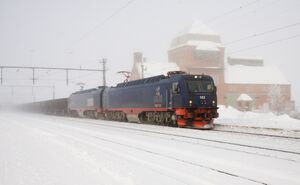
في عام 1884، مُنحت "شركة سكك حديد شمال أوروبا" امتياز لخط سكة حديد من لوليو إلى نارڤيك. تم الانتهاء من السكك الحديدية المؤقتة بين لوليو ومالمبريت في عام 1888 وغادر أول قطار مالمبريت في مارس. حينها، أفلست الشركة الإنجليزية واضطرت إلى بيع الخط للدولة السويدية مقابل 8 ملايين كرون سويدي، أي حوالي نصف مبلغ الاستثمار في البداية. بعد عملية إعادة بناء ضخمة، يمكن استخدام خط السكة الحديد إلى ياليڤاره مرة أخرى واستخراج خام الحديد في مالمبريت بواسطة Aktiebolaget Gellivare Malmfält (AGM).[10][11]
أُسست Luossavaara-Kiirunavaara Aktiebolag (LKAB) بمبادرة من روبرت شوج، في عام 1890. وفي عام 1893، أصبح گوستاف برومز الرئيس التنفيذي لكل من LKAB و AGM. ضغطت LKAB لمواصلة مالمبانان عبر لوسڤارا وكيروناڤارا إلى الساحل الخالي من الجليد في النرويج. أثار استمرار خط السكة الحديد إلى نارڤيك الجدل، لأن المعارضين يخشون تأثير روسيا (ثم السيطرة على فنلندا والمتصلين بالفعل بالسويد في هاپاراندا - تورنيو) على خط سكة حديد دولي.
في عام 1898 اتخذ قرار البناء في النهاية. وصل خط السكة الحديد إلى كيرونا في 15 أكتوبر 1899 وانضم إلى القسمين السويدي والنرويجي في 15 نوفمبر 1902. بالنسبة لشركة LKAB، أدت النفقات الكبيرة تقريباً إلى الإفلاس في عام 1901، بعد تعدين الخام في كيروناڤارا مباشرة قد بدأ. كما افتتح الملك أوسكار الثاني خط السكة الحديد في 14 يوليو 1903 مفضلاً الصيف على الشتاء للسفر شملًًا.[10][11][12]
عُين لتصميم المدينة المهندسين المعماريين پير أولوف هالمان وگوستاف وكمان، التي سيتم بناؤها في هاوكيڤارا، بالقرب من كل من مناجم خام الحديد، مع مراعاة الظروف الجغرافية والمناخية حينها؛ يجري بناؤها على تل، درجات الحرارة في فصل الشتاء تكون أكثر اعتدلاً من المدن الأخرى، وبسبب مخطط الشارع والموقع، تكون الرياح محدودة. في 27 أبريل 1900، قُبلت خطة هالمان رسمياً.
اقترح گوستاف برومز تسمية المستوطنات كيرونا، وهو اسم قصير وعملي يمكن أن يلفظه أيضاً السكان الناطقون باللغة السويدية. الاسم يعني ترمجان الصخر باللغتين السامية والفنلندية. وقد عينت LKAB جالمار لنبم، الذي لم يكمل دراسته الثانوية ولا دراساته الجيولوجية، بمنصب مدير محلي في كيرونا.[13][14][15]
التاريخ المبكر
Before the design for the settlement had been accepted, houses were built in a disorganized manner with illegal slums similar to those in the other mining town, Malmberget, 80 كيلومتر (50 mi) south of Kiruna. Also, provisional buildings served as a church, a school, a hospital, a hotel and a police station. However, official residences were built at a high pace, and when the king opened the railway in 1903, all illegal residences and most other provisional buildings had been demolished and replaced. The very first building, B:1, is preserved and can be seen at Hjalmar Lundbohmsgården. In 1899, 18 people were registered as living in soon-to-be Kiruna. This increased to 222 in 1900, 7,438 in 1910 and 12,884 in 1930.
The residences did not fully keep up with this rapid growth; by 1910, there were 1,877 official rooms and some unrecognised residences, which meant that an average of three to four people lived in a single room; this density decreased steadily during the decades to follow. Kiruna became a municipalsamhälle (a community within a municipality) in 1908. This caused unhappiness in local organisations, such as Luossavaara-Kiirunavaara Arbetareförening, that had hoped for status as köping, which would have kept more of the mining income inside the locality. In return, the mining company LKAB paid for a hospital, fire station, sewerage, roads, a church (opened 1912) and the priest's home.[9][11][13]
In April 1907, a tram began operation in Kiruna, the northernmost in the world. This meant miners would no longer have to walk several kilometres through the sub-arctic cold, nor would they need to climb a hundred meters up the mining hill. The network consisted of three lines: bergbanan (funicular), stadsspårvägen (city tramway) and gruvspårvägen (mine tramway). The funicular closed in 1955 after a road up the mine was built 1949. The city line had a maximum length of 8 كيلومتر (5.0 mi) and was unique due to the 1-meter gauge, double windows and heated wagons. It closed in 1958 after gradually being replaced by buses. Between 1941 and 1964, a tram was used inside the mine, with wagons bought from closed tramlines throughout Sweden.[12]
The iron ore industry was good in the early 20th century. Before the start of the work, Hjalmar Lundbohm worried whether the Kiruna winter would allow for working outside at all, but despite early research into underground mining, mountaintop removal mining was the primary method in the early years. Mechanisation was attempted early using steam powered excavators, but the cold climate led to considerable difficulties and only when electrical machinery became available in the 1910s, significant mechanisation was achieved. The peak of Kiirunavaara, Statsrådet, was 247.7 متر (813 ft) above Luossajärvi until it was spectacularly blown off in 1910.[10][11]
A general strike hit Sweden in 1909 and Kiruna was no exception. Hoping for a better future, thousands of people left Kiruna, including a group of 500 inhabitants emigrating to Brazil. Most of them returned, disappointed that life in Latin America was not what they had hoped it to be. Hjalmar Lundbohm personally lent money for the trip home to some of the emigrants.[10][11]
During World War I, iron ore production dropped to the lowest level in LKAB's history, and when exports increased again, a successful three-month strike in 1920 led to a 20% increase in salaries for the miners. Production dropped to a minimum in 1922 and a three-day work week was introduced, but during the fabulous twenties, it increased to a record nine million tonnes in 1927.[11]
In 1921, mining started at Kiruna's other hill, Luossavaara. However, the total amount of ore that could be mined in open pit mining here was small compared to Kiirunavaara, and LKAB preferred to concentrate resources in one place. Nevertheless, mining here continued until 1974 and later it became a research mine.[10][11] While 19th-century mining in Kiruna had focused on Luossavaara the large-scale operation of LKAB focused on the Kiruna ore proper because it was both larger and not subject to legal restrictions that mandate Luossavaara ore to be refined in Sweden.[16]
During the first decades of Kiruna's existence, no road connected it to the outside world. The only connection was by railway or, as in the time before the railway, by boat (in summer) via the Torne and Kalix rivers to Jukkasjärvi and Håmojåkk and then proceed by foot. A road from Kiruna was built to Tuolluvaara in 1901, Poikkijärvi in 1909, Alttajärvi in 1913 and connected to Svappavaara in 1926, from where roads already connected via Vittangi to Pajala and via Lappesuando to Gällivare and further south.[12]
The Great Depression led to a 70% drop in ore production, a drop that would turn into a dramatic increase on the eve of World War II.[11]
Although some tourists had already started coming to the area in the 19th century, the completion of the railway line truly made tourism possible. Tourists came for the rivers and the mountains, but also geologists and entire classes of students came to see the mine. Additionally, a yearly winter sports festival was started, which attracted people from a wide area. The Sami population was already a tourist attraction in the early days of Kiruna's existence.[17]
In the early 1920s a movement that became known as "Kirunasvenskarna" (the Kiruna Swedes) decided to emigrate to Soviet Russia, the land where they hoped for better working conditions and higher wages and general standards. They were the last Swedes who emigrated in groups and also within entire group of emigrating Swedes, the ones who must have got the worst chock in their new homeland which was just about to get Stalin as autocratic ruler. Most of these emigrants lived in Kiruna prior to their move.[18]
الحرب العالمية الثانية
The municipality of Kiruna shares borders with Norway and Finland and Kiruna is located relatively close to both countries. This led to many soldiers being transported to the area whenever mobilisation was requested; first in September 1939 after the German invasion of Poland, then in November 1939 after the Russian invasion of Finland, but in both cases, Swedish soldiers did not engage in any fighting. In March 1940, Churchill requested permission to transport soldiers from Narvik in Norway to Finland via Kiruna and Haparanda in Operation Catherine. Out of fear that the presence of British soldiers near the Kiruna ore mine would provoke a German attack on Sweden, the request was declined.[19]
After the German invasion of Norway, at least ten soldiers were stationed along every bridge along Malmbanan, to blow up the bridges should the German army invade Sweden. Additionally, foreigners were banned from visiting Kiruna or the iron ore line, and only the Sami, military personnel, locals and people working for the government were permitted to travel between Kiruna and Riksgränsen.[19]
After the battle at Bjørnfjell, 15 April 1940, wounded and fallen Norwegian soldiers were transported to Kiruna.[19]
Despite the conditions for Swedish neutrality, rail cars with food, skis and helmets were transported from Kiruna to the Norwegian soldiers in Bjørnfjell.[19]
Swedish iron ore from Kiruna was of major importance to the German war machine. A group of people working at LKAB organised in the Wollweberliga, planning to sabotage transports to Germany. In late November 1941, Edvard Nyberg, Ernst Wollweber and others produced a mine to be attached to the ore cars. Nyberg was caught, was fired from LKAB and spent 31⁄2 years in prison. Upon his release, he founded Nybergs Mekaniska Verkstad which is still one of Kiruna's biggest companies.[19][20][21]
Germany requested that Sweden provide use of the railway network to transport military equipment, but the Swedish government agreed only to transitering av human karaktär, men ej underhåll till stridande trupp (transit of humanitarian character, but no supply of fighting soldiers). Germany argued that, now that Norway was occupied, the German soldiers there were no longer fighting, and thus transported a large amount of military equipment, ammunition and, secretly, troops from southern to northern Norway, via Malmbanan and Kiruna. Troops were often transported in transports declared as material transports. Despite being strictly against the rules, there was considerable interaction between the German soldiers and the Swedish locals, including trading and football matches.[19]
During the war, up to 2000 refugees from 20 countries were kept in Kiruna. German prisoners of war, for example, from crashed airplanes, were kept in Kiruna before being transported south. However, small-scale sabotage, such as sand in the engines, was common and loose weapons often ended up at the bottom of the Luossajärvi lake, next to the railway stop.[19]
North of Torneträsk, at Kaivare, a radio base Kari was built in secrecy and used by the Norwegian resistance. It was also used for the smuggling of arms to Norway and refugees from Norway.[19][22]
بعد الحرب
In 1948, Kiruna gained city rights and started to receive large amounts of money from the mine. The city centre was renovated starting in 1953; most buildings built before 1920 were demolished and replaced, and many of the current buildings were built in the following period. The town grew and new neighborhoods were built, as well as new apartment buildings and villas in existing neighborhoods. The area is currently known as Lombolo was built in the 1960s.[13]
After World War II, the economy of Kiruna started to diversify. Initially, the mechanisation of the mining industry led to more mechanical workshops developing machinery for the mine, still dependent on the mining, but individual companies with spinoffs that could be sold to other areas than the Kiruna mine alone. In the 1950s, a fund, Norrlandsfonden was established, in which profits from LKAB would be invested in order to diversify the local economy. The municipality started to lend money to starting companies against very beneficial rates, a scheme that lasted until 1959 because the banks, that insisted this was false competition, had established more relaxed rules for lending out money. The industrial area east of the city was built in the 1950s to separate industry from neighborhoods.[23]
On 10 November 1960, Kiruna Airport opened to separate civilian air traffic from the military airplanes that had landed at Kalixfors airport and at Luossajärvi since World War I. A road to Nikkaluokta was opened in 1971 and to Riksgränsen and Narvik in 1984. The latter had been debated heavily, for alternative plans existed to build the road to Norway on the northern side of Torneträsk, via Laimo, Kattuvuoma, Salmi to Innset and Bardu in Norway. This road was never built, but a 25 km long track between Laimo and Salmi was built at the initiatives of the locals and finished in 1962; however, this track, called Talmavägen, is not connected to any other road.[12]
Increased communications were also beneficial for tourism. Swedish Railways had already run special trains before World War II, but started a special Dollar train in the summer months between Gothenburg and Kiruna, connecting to cruise ships from the United States. The canoe club Kiruna Långfärdspaddlare was founded in 1972 and rafting for tourists restarted after it had been discontinued for 20 years due to the drowning of Valfrid Johansson. Until the 1980s, tourism had been mainly a summer business, but touristic exploitation of dog sledging was started in 1983 in Jukkasjärvi. In 1990, the first Icehotel was built in Jukkasjärvi and advertised as the world's largest igloo. It had been built using techniques from the building of Malmbanan 90 years before and was also inspired by the Snow Festival, that had started in 1986 to celebrate the Swedish Viking satellite. Since 1998, a special tourist area exists in the mine and since 1999, tourists can visit the various areas of research going on in Kiruna.[17]
In 1957, the Kiruna Geophysical Observatory (KGO) (now the Swedish Institute of Space Physics) was founded and established by the Royal Swedish Academy of Sciences. Esrange Space Centre is established in 1966. Here, rocket operations and ground-based observations are carried out since 1966, balloon operations since 1974, satellite operations since 1978 and testing operations since 2000 (with the Swedish Defence Material Administration). ESA has operated a satellite station at Salmajärvi, near Esrange, since 1989. In 1987, Umeå University started a space engineering program in Kiruna, and GIS education was started by Luleå University of Technology in 1991. In 1993, The Umeå space engineers moved to the same building housing IRF and a year later another Luleå University programme, civil engineering with specialisation in space technology, started at the same location. Since 2006, the Erasmus Mundus Master Course in Space Science and Technology has started with at least one semester spent at LTU. In 2007, education along IRV was split and only the Department of Space Science, belonging to Luleå University of Technology, remained, while the Umeå University programme in Space Engineering quit.[5][24][25][26]
The Kiruna Icehotel has been built in Jukkasjärvi each winter since 1990 and is a major tourist attraction.[27]
نقل البلدة
The re-development of Kiruna is a reconstruction project, as the Kirunavaara mine, run by LKAB, undermines the existing town centre. Several buildings are to be moved or demolished. The town center is to be moved 3 كيلومتر (1.9 mi) to the east.[28]
In 2004, it was decided that the present centre of the municipality would have to be relocated to counter mining-related subsidence.[29] The relocation would be made gradually over the coming decade. On January 8, 2007, a new location was proposed, northwest to the foot of the Luossavaara mountain, by the lake of Luossajärvi.[30]
The first actual work on moving the town was done in November 2007, when work on the new main sewage pipe started.[31]
In the same week, first sketches for the layout of the new part of the town became available.[32] The sketches include a travel centre, the new locations for the city hall and the church, an artificial lake and an extension of the Luossavaara hill into the city.[33] The location of the new section of the E10 was still uncertain, as was the location of the railway and the railway station. A more official sketch was published early in spring 2008, which was then discussed with various interest groups before a further version was to be produced.
In June 2010 the municipal council decided that the town would be moved eastwards (to 67°51′1″N 20°18′2″E / 67.85028°N 20.30056°E), in the direction of Tuolluvaara, instead of the proposed northwestern location.[34] The moving of the town was started in 2014 and the plan describes a process that continues to 2100.[35] The years 2012-2013 an international architectural competition concerning the vision, strategy and design of a new city centre for a new Kiruna was arranged by the Municipality of Kiruna in partnership with the Swedish Association of Architects. White Arkitekter AB based in Stockholm together with Ghilardi + Hellsten Arkitekter based in Oslo, Spacescape AB, Vectura Consulting AB and Evidens BLW AB won the competition with their masterplan and strategy for moving the city. The competition team was led by White Arkitekter AB, Lead Architect Mikael Stenqvist Architect SAR/MSA, in collaboration with Ghilardi + Hellsten Arkitekter, Lead architect Ellen Hellsten,[36] Together with researchers from Luleå and Delft universities, which envisages a denser city centre with a greater focus on sustainability, green and blue infrastructure, pedestrians and public transport rather than automobiles.[37] In 2018, Swedish government announced that it would help arrange replacement work for radio corporation Radiotjänst after the city had been moved from its original location.[38]
Starting in 2013 Danish explorer and photographer Klaus Thymann began a long-term project documenting the resettlement of the town. Using GPS-tagged imagery he has returned multiple times since, replicating precise locations to show the changing landscape.[39] In 2017 Thymann returned again to Kiruna to document the redevelopment of the town for Bloomberg Businessweek [40]
الجغرافيا
Kiruna is located in the north of Sweden, 145 كيلومتر (90 mi) north of the Arctic circle. The city centre is built on the Haukavaara hill at an altitude of 530 m, high above the Torne river to the north and the Kalix river to the south. Other parts of the town are Lombolo and Tuolluvaara. Near Kiruna are the mountains Kiirunavaara and Luossavaara. Kiirunavaara is an iron ore mine that is the town's primary economic resource. Luossavaara is a former mine and now used as a skiing slope.
The city is built near the lake Luossajärvi with outflow to the Luossajoki that flows in the Torne river at Laxforsen. The area around Kiruna is very sparsely populated. The northwest, west and southwest of Kiruna are dominated by the Scandinavian mountains, visible from the city centre. Sweden's highest mountain, Kebnekaise, is 75 كيلومتر (47 mi) from the city centre and can be seen from it as well. To the west is Nikkaluokta and to the northwest are Abisko, Björkliden, Riksgränsen and the Norwegian town of Narvik, 180 كيلومتر (110 mi) via the road. 12 كيلومتر (7 mi) north of Kiruna is Kurravaara, on the edge of the Torne River. The land north of Kurravaara is roadless, uninhabited, partly barren and partly birch forest, up to the Norwegian and Finnish borders at Treriksröset. The lower-lying east is dominated by boreal forest, stretching thousands of kilometres through Finland and Russia. Around 15 km east of Kiruna is a group of villages at the Torne River, most notably Jukkasjärvi, where an ice hotel is built each winter, attracting tourists from all over the world. The twin cities Gällivare and Malmberget are some 120 km south of Kiruna.
Kiruna became a Swedish city on January 1, 1948, and was at one time listed as the largest city in the world by area,[41] even if most of its territory was non-urban. After the Swedish municipality reform in the 1970s, the term "city" has been legally discontinued. Today only the built-up area is considered a de facto city.
المناخ
Being located 145 km (90 miles) north of the Arctic Circle, Kiruna has a subarctic climate (Dfc) with short, cool summers and long, cold winters, although the city itself can be considerably milder than the surrounding forest. Snow cover generally lasts from late September to mid-May, but snowfall can occur year-round. The midnight sun between 28 May and 16 July (50 days), and white nights lasts from early May to early August. Polar night lasts from 11 December to 1 January (22 days), the exact boundaries depending on local topography. Even though Kiruna's winters are very cold by Swedish standards, they are still much less severe than winters on similar latitudes in North America and Siberia, and even more southerly areas in other parts of the world due to some maritime influence. Similar winter temperatures go as far south as below the 45th parallel in the Russian Far East. Kiruna however, has cooler summers than such areas, but still warm enough to stay above polar climate and below the northern tree line. Winter temperatures however are significantly colder than areas immediately affected by the Gulf Stream to a degree that the regular lows of Kiruna during January and February are similar to Tromsø's all-time record low.
The coldest confirmed temperature ever in Kiruna was recorded at the nearby weather station with −43.3 °C (−45.9 °F) recorded in January 1999.[42] The weather station recorded 31.6 °C (88.9 °F) in July 1945, which is the all-time record.[43] The warmest month on record at the weather station was July 2018, with average high temperatures of 24.3 °C (75.7 °F).[44] Kiruna has a gloomy climate, affected by Atlantic low-pressure systems. Due to its extreme daylight cycle, the period between April to August account for 73% of Kiruna's annual sunshine according to the 1961-1990 normals, whereas the five darkest months between October and February contain only around 10% of the annual sunshine.
| بيانات المناخ لـ Kiruna Airport (2002–2021 averages, extremes since 1901), precipitation from Rensjön | |||||||||||||
|---|---|---|---|---|---|---|---|---|---|---|---|---|---|
| الشهر | ينا | فب | مار | أبر | ماي | يون | يول | أغس | سبت | أكت | نوف | ديس | السنة |
| القصوى القياسية °س (°ف) | 7.3 (45.1) |
8.1 (46.6) |
9.5 (49.1) |
16.6 (61.9) |
24.9 (76.8) |
28.5 (83.3) |
31.6 (88.9) |
27.7 (81.9) |
23.3 (73.9) |
16.1 (61.0) |
10.1 (50.2) |
8.7 (47.7) |
31.6 (88.9) |
| متوسط القصوى اليومية °س (°ف) | −7.9 (17.8) |
−6.7 (19.9) |
−2.4 (27.7) |
3.1 (37.6) |
8.9 (48.0) |
14.8 (58.6) |
18.5 (65.3) |
15.9 (60.6) |
10.2 (50.4) |
2.5 (36.5) |
−2.8 (27.0) |
−5.1 (22.8) |
4.1 (39.4) |
| المتوسط اليومي °س (°ف) | −12.4 (9.7) |
−11.2 (11.8) |
−7.1 (19.2) |
−1.3 (29.7) |
4.7 (40.5) |
10.3 (50.5) |
13.8 (56.8) |
11.5 (52.7) |
6.5 (43.7) |
−0.7 (30.7) |
−6.5 (20.3) |
−9.3 (15.3) |
−0.1 (31.7) |
| متوسط الدنيا اليومية °س (°ف) | −16.8 (1.8) |
−15.7 (3.7) |
−11.8 (10.8) |
−5.6 (21.9) |
0.5 (32.9) |
5.7 (42.3) |
9.1 (48.4) |
7.0 (44.6) |
2.7 (36.9) |
−3.8 (25.2) |
−10.1 (13.8) |
−13.4 (7.9) |
−4.3 (24.2) |
| متوسط الدنيا °س (°ف) | −29.1 (−20.4) |
−28.1 (−18.6) |
−23.6 (−10.5) |
−16.2 (2.8) |
−6.7 (19.9) |
0.2 (32.4) |
3.1 (37.6) |
0.3 (32.5) |
−4.0 (24.8) |
−14.2 (6.4) |
−22.5 (−8.5) |
−25.1 (−13.2) |
−32.0 (−25.6) |
| الصغرى القياسية °س (°ف) | −40.1 (−40.2) |
−42.3 (−44.1) |
−36.8 (−34.2) |
−31.1 (−24.0) |
−21.0 (−5.8) |
−5.0 (23.0) |
−1.8 (28.8) |
−5.0 (23.0) |
−11.8 (10.8) |
−28.8 (−19.8) |
−32.3 (−26.1) |
−37.5 (−35.5) |
−42.3 (−44.1) |
| متوسط تساقط الأمطار mm (inches) | 25.7 (1.01) |
20.2 (0.80) |
15.2 (0.60) |
19.3 (0.76) |
44.8 (1.76) |
54.6 (2.15) |
92.7 (3.65) |
66.2 (2.61) |
57.8 (2.28) |
39.6 (1.56) |
25.8 (1.02) |
31.5 (1.24) |
493.4 (19.44) |
| Mean monthly ساعات سطوع الشمس | 8 | 69 | 162 | 208 | 238 | 244 | 244 | 180 | 118 | 75 | 21 | 0 | 1٬567 |
| Source 1: SMHI Open Data for Rensjön A, precipitation[45] | |||||||||||||
| Source 2: SMHI Open Data for Kiruna flygplats, temperature[46] | |||||||||||||
| بيانات المناخ لـ كيرونا (إسرانگى 2002–2018، القصوى منذ 1901) | |||||||||||||
|---|---|---|---|---|---|---|---|---|---|---|---|---|---|
| الشهر | ينا | فب | مار | أبر | ماي | يون | يول | أغس | سبت | أكت | نوف | ديس | السنة |
| القصوى القياسية °س (°ف) | 7.3 (45.1) |
7.3 (45.1) |
11.3 (52.3) |
15.2 (59.4) |
27.0 (80.6) |
29.8 (85.6) |
31.6 (88.9) |
28.4 (83.1) |
24.3 (75.7) |
16.1 (61.0) |
9.2 (48.6) |
8.0 (46.4) |
31.6 (88.9) |
| متوسط القصوى اليومية °س (°ف) | −9.1 (15.6) |
−7.2 (19.0) |
−1.8 (28.8) |
4.0 (39.2) |
10.3 (50.5) |
15.5 (59.9) |
19.7 (67.5) |
16.8 (62.2) |
10.9 (51.6) |
2.9 (37.2) |
−3.4 (25.9) |
−6.1 (21.0) |
4.4 (39.9) |
| المتوسط اليومي °س (°ف) | −14.0 (6.8) |
−12.2 (10.0) |
−7.3 (18.9) |
−0.9 (30.4) |
5.4 (41.7) |
10.6 (51.1) |
14.5 (58.1) |
11.8 (53.2) |
6.6 (43.9) |
−0.6 (30.9) |
−7.5 (18.5) |
−10.9 (12.4) |
−0.4 (31.3) |
| متوسط الدنيا اليومية °س (°ف) | −18.8 (−1.8) |
−17.2 (1.0) |
−12.8 (9.0) |
−5.7 (21.7) |
0.5 (32.9) |
5.7 (42.3) |
9.2 (48.6) |
6.8 (44.2) |
2.3 (36.1) |
−4.1 (24.6) |
−11.6 (11.1) |
−15.7 (3.7) |
−5.1 (22.8) |
| متوسط الدنيا °س (°ف) | −32.9 (−27.2) |
−31.4 (−24.5) |
−27.3 (−17.1) |
−17.1 (1.2) |
−6.5 (20.3) |
−0.6 (30.9) |
2.9 (37.2) |
−0.7 (30.7) |
−4.7 (23.5) |
−15.0 (5.0) |
−24.9 (−12.8) |
−29.5 (−21.1) |
−35.7 (−32.3) |
| الصغرى القياسية °س (°ف) | −43.3 (−45.9) |
−42.3 (−44.1) |
−36.8 (−34.2) |
−31.1 (−24.0) |
−21.0 (−5.8) |
−5.8 (21.6) |
−1.8 (28.8) |
−4.0 (24.8) |
−11.8 (10.8) |
−28.8 (−19.8) |
−34.6 (−30.3) |
−38.0 (−36.4) |
−43.3 (−45.9) |
| متوسط تساقط الأمطار mm (inches) | 37.7 (1.48) |
29.8 (1.17) |
19.4 (0.76) |
20.9 (0.82) |
45.7 (1.80) |
70.9 (2.79) |
100.6 (3.96) |
72.2 (2.84) |
64.8 (2.55) |
42.0 (1.65) |
41.4 (1.63) |
42.3 (1.67) |
587.7 (23.12) |
| Mean monthly ساعات سطوع الشمس | 8.9 | 69.8 | 161.8 | 203.8 | 236.9 | 227.1 | 245.5 | 182.5 | 117.2 | 80.9 | 21.5 | 0.0 | 1٬555٫9 |
| متوسط مؤشر فوق البنفسجية | 0 | 0 | 1 | 2 | 3 | 4 | 4 | 3 | 2 | 1 | 0 | 0 | 2 |
| Source 1: Swedish Meteorological and Hydrological Institute[47][48] | |||||||||||||
| Source 2: Ultraviolet Index [49] | |||||||||||||
النقل
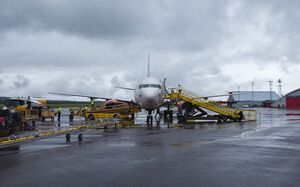
Kiruna is on the E10 road, connecting Luleå with Norway and passing near Gällivare (south of Kiruna) and Narvik (on the Norwegian coast). A short road connects to Kurravaara at the Torne river and ends there. Another road connects Kiruna with Nikkaluokta close to Kebnekaise and is used by tourists to get to the mountains. It passes by or nearby several villages in the Kalix river valley.
Buses connect Kiruna with major towns in Norrbotten province and villages nearby and in the wider region. The railway connects Luleå with Gällivare, Kiruna and Narvik. Although built to serve the mine, Swedish Rail runs daily passenger traffic on the line: a night train from Narvik to Stockholm, a day train from Narvik to Luleå (connecting with a second night train to Stockholm and Gothenburg), and trains to Luleå and Narvik that start and finish in Kiruna. The latter is known as Karven and popular for day trips to the mountains near Abisko, Björkliden and Riksgränsen, particularly in winter. Additional long-distance trains are run by Transdev in summer. In 2013, the railway station was moved 2 km away from the city centre, so walking is possible but not recommended. There is a free shuttlebus for every departure and arrival which starts from Kiruna bus station in the city centre.
Kiruna Airport is southeast of the city, 8 km by road. A few daily flights connect Kiruna with Stockholm, either directly or via Luleå or Umeå. An airport bus is available for all flights to and from Stockholm-Arlanda Airport.[50]
الاقتصاد
أبحاث الفضاء
Space research started in the late 1940s.[5]
The ESTRACK Kiruna Station of ESA, the European Space Agency, is located in the municipality. So is Esrange, the European Space and Sounding Rocket Range, as well as an EISCAT station and EISCAT scientific headquarters.[51]
Also in Kiruna are the Institute of Space Physics[6] and the Department of Space Science belonging to Luleå University of Technology.[7]
In 2007, the Swedish government announced that Kiruna would be the host of Spaceport Sweden, signing an agreement with Virgin Galactic.[52][53]
التعدين
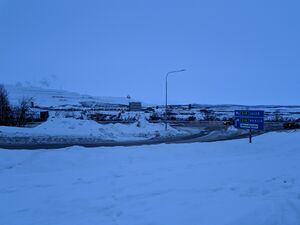
Mining plays a major role as a source of national income and employment for Kiruna and the surrounding region. As with most of Northern Sweden the area is rich with Magnetite which is mined to produce various Iron ore products which are then transported by rail to Narvik port in Norway to be shipped to customers around the world. Large-scale mining in Kiruna started in the 19th century right around the time the major Swedish mining company LKAB was founded in 1890.[54]
السياحة

In winter, the Icehotel in nearby Jukkasjärvi and the northern lights attract tourists. The long and certain snow cover, which generally lasts from October to May, and frozen lakes and rivers facilitate cross-country and alpine skiing, dog sledding and snowmobiling. There is ice climbing in the mountains and ice skating on lakes or rivers. The annual Snow Festival is held over the last weekend of January[55] and includes scooter jumping, reindeer racing and an ice sculpture contest.[17][56][57]
الرياضة
- Kiruna FF is a Swedish football club located in Kiruna. The club currently competes in Division 3 Norra Norrland, the fifth tier of the Swedish football league system.
- Kiruna IF is a Swedish ice hockey club located in Kiruna. The club currently competes in Hockeyettan, the third tier of the Swedish ice hockey league system.
- Kebnekaise BTK [58] is a table-tennis club located in Kiruna. The club competes in Div 1 Norra, the third tier of the Swedish table-tennis league system. Kebnekaise BTK has consistently been one of Northern Sweden's most successful table-tennis clubs. Practice takes place in Sporthallen,[59] the sports center located in central Kiruna.
سكان بارزون
- Svarta Bjorn, legendary female cook during the founding of the town
- Emma Eliasson, ice hockey defender in the Swedish Women's Hockey League, and member of the Sweden women's national ice hockey team
- Börje Salming, National Hockey League (NHL) ice hockey defenceman; member of the Hockey Hall of Fame
- Per Spett, Olympic mogul skier
- Philip Kemi, Swedish professional ice hockey player
- Hanna Öberg, Olympic champion biathlon
- Elvira Öberg, Olympic champion biathlon
مدن توأم
انظر أيضاً
- Esrange
- Jänkänalusta
- Kauppinen
- كنيسة كيرونا
- Kiruna Station
- Radiotjänst in Kiruna
- Spaceport Sweden
- Swedish Institute of Space Physics
المراجع
- ^ أ ب "Tätorternas landareal, folkmängd och invånare per km2 2005 och 2010" (in السويدية). Statistics Sweden. 14 December 2011. Archived from the original on 27 January 2012. Retrieved 10 January 2012.
- ^ Sahlgren, Jöran; Bergman, Gösta (1979). Svenska ortnamn med uttalsuppgifter (in السويدية). p. 14.
- ^ Statistikdatabasen - Folkmängd efter region och vart 5:e år[dead link]
- ^ "Folkmängd efter region och år, 2016" (in السويدية). Statistics Sweden. 2018-01-25. Retrieved 2018-01-25.
- ^ أ ب ت Backman, Fredrick (2015). Making Place for Space: a History of 'Space Town' Kiruna 1943-2000. Umeå, Sweden: Umeå University. ISBN 978-91-7601-244-4.
- ^ أ ب "IRF Kiruna". Retrieved 2009-02-03.
- ^ أ ب "Welcome to the Department of Space Science". Retrieved 2009-02-03.
- ^ أ ب ت Kummu 1997, p. 96.
- ^ أ ب "Historia – Kiruna kommun" (in السويدية). Archived from the original on June 25, 2008. Retrieved 2009-02-09.
- ^ أ ب ت ث ج ح "Press room/History/1696–1919@lkab.com". Retrieved 2009-02-09.
- ^ أ ب ت ث ج ح خ د Barck, Åke (27 April 2000). "Gruvstaden – Gruvorna". Kiruna 100-årsboken (in السويدية). Kiruna: Kiruna kommun. pp. 60–74. ISBN 91-630-9371-5.
- ^ أ ب ت ث Theander, Agge; Aidenpää, Elis; Bergström, Rolf (27 April 2000). "Komunikationer – Från hästskuts till e-post". Kiruna 100-årsboken (in السويدية). Kiruna: Kiruna kommun. pp. 132–147. ISBN 91-630-9371-5.
- ^ أ ب ت Persson, Curt; Jan-Erik Johansson (27 April 2000). "Kiruna – Från ödemark till stad". Kiruna 100-årsboken (in السويدية). Kiruna: Kiruna kommun. pp. 27–43. ISBN 91-630-9371-5.
- ^ Persson, Curt (27 April 2000). "Kiruna – Hjalmar Lundbohm". Kiruna 100-årsboken (in السويدية). Kiruna: Kiruna kommun. pp. 50–57. ISBN 91-630-9371-5.
- ^ "Kiruna – technical visits". Archived from the original on 2012-02-20. Retrieved 2009-02-09.
- ^ Hansson 2015, p. 212.
- ^ أ ب ت Barck, Åke (27 April 2000). "Näringsliv och forskning – Turismen". Kiruna 100-årsboken (in السويدية). Kiruna: Kiruna kommun. pp. 60–74. ISBN 91-630-9371-5.
- ^ "Vilka var Kirunasvenskarna?".
- ^ أ ب ت ث ج ح خ د Theander, Agge; Roth, Thomas (27 April 2000). "I skuggan av krigen". Kiruna 100-årsboken (in السويدية). Kiruna: Kiruna kommun. pp. 234–250. ISBN 91-630-9371-5.
- ^ "Start - NMV Group". NMV Group.
- ^ Sternlund, Hans. "De fick prestigefyllt pris". Norrländska Socialdemokraterna (in السويدية). Retrieved 22 February 2009.
- ^ Svensson, Anders (11 July 2008). "Sverige, USA, FRA och signalspaning". Internationalen (in السويدية). Retrieved 22 February 2009.[dead link]
- ^ Nilsson, Kjell (27 April 2000). "Näringsliv och forskning – Från AK till IT". Kiruna 100-årsboken (in السويدية). Kiruna: Kiruna kommun. p. 86–90. ISBN 91-630-9371-5.
- ^ "Overview – Swedish Institute of Space Physics". Archived from the original on 2008-12-20. Retrieved 2009-02-09.
- ^ "Esrange space centre – history". Retrieved 2009-02-09.
- ^ Theander, Agge (27 April 2000). "Näringsliv och forskning – Rymd, miljö och gruva". Kiruna 100-årsboken (in السويدية). Kiruna: Kiruna kommun. p. 116–129. ISBN 91-630-9371-5.
- ^ "ICEHOTEL". Retrieved 2009-02-09.
- ^ "Kiruna: the town being moved 3km east so it doesn't fall into a mine". The Guardian. 22 October 2014. Retrieved 29 October 2017.
- ^ Golling, Daniel; Mínguez Carrasco, Carlos (2020). Kiruna forever. Stockholm: ArkDes. ISBN 978-91-985112-5-3. OCLC 1155398269.
- ^ TT (2007-01-08). "Klart med Kirunas flytt". Dagens Nyheter (in السويدية). Retrieved 2015-10-24.
- ^ Rosengren, Jessica (2007-11-23). "Kirunaflytten är igång". Norrländska Socialdemokraten (in السويدية). Retrieved 2015-10-24.
- ^ Rosengren, Jessica (2007-11-23). "Nu finns det skiss över nya Kiruna". Norrländska Socialdemokraten (in السويدية). Retrieved 2007-11-25.
- ^ Skissförslag nov.-07 Archived 2008-04-08 at the Wayback Machine
- ^ "Framtida placeringen av Kiruna klar". Dagens Nyheter (in السويدية). 2010. Archived from the original on February 23, 2011. Retrieved January 8, 2007.
{{cite news}}: CS1 maint: bot: original URL status unknown (link) - ^ "FAQ - Kiruna kommun". www.kiruna.se. Archived from the original on 2016-09-18. Retrieved 2016-08-21.
- ^ https://www.arkitekt.se/app/uploads/2014/06/T%C3%A4vlingar-2013-Ny-stadsk%C3%A4rna-i-Kiruna-Jury-Pronouncement.pdf[bare URL PDF]
- ^ Kinder, Tabby (6 March 2014). "Kiruna: How to move a town two miles east". BBC News. Retrieved 2014-03-06.
- ^ Nyheter, S. V. T.; Palomäki, Teuvo (30 May 2018). "Congratulations to Kiruna". SVT Nyheter.
- ^ Kotsoni, E. (24 February 2014). "The Swedish Town Being Swallowed by the Earth". VICE.
- ^ Dean, J. (5 September 2017). "The Complicated Audacious Plan to Move a Swedish Mining Town". Businessweek.
- ^ "Historien om världens största stad" (in السويدية). Norrländska Socialdemokraten. Retrieved 2008-11-30.
- ^ "Temperature and Wind for January 2015 - All Time Records section" (PDF). Swedish Meteorological and Hydrological Institute. Archived from the original (PDF) on 16 October 2015. Retrieved 20 February 2015.
- ^ "Temperature and Wind for July 2014 - All Time Records section" (PDF). Swedish Meteorological and Hydrological Institute. Archived from the original (PDF) on 16 October 2015. Retrieved 20 February 2015.
- ^ "July 2018 Temperature & Wind" (PDF) (in السويدية). SMHI. Retrieved 25 April 2019.
- ^ "Open Data for Rensjön A, precipitation" (in السويدية). Swedish Meteorological and Hydrological Institute. Retrieved 23 March 2022.
- ^ "Open Data for Kiruna flygplats, temperature" (in السويدية). Swedish Meteorological and Hydrological Institute. 23 March 2022.
- ^ "SMHI Open Data for Esrange" (in السويدية). Swedish Meteorological and Hydrological Institute. Archived from the original on 2019-04-11. Retrieved 2009-05-15.
- ^ "Monthly & Yearly Statistics 2002–2018" (in السويدية). Swedish Meteorological and Hydrological Institute. Archived from the original on 2015-02-20. Retrieved 2019-05-15.
- ^ "Weather Report for Kiruna". Retrieved 8 December 2020.
- ^ "Bus". www.swedavia.com.
- ^ "What is EISCAT?". Archived from the original on 2009-06-20. Retrieved 2009-02-03.
- ^ "Spaceport Sweden". www.spaceportsweden.com. Archived from the original on 2021-02-15. Retrieved 2022-01-25.
- ^ "SSC - Swedish Space Corporation - SSC". www.ssc.se.
- ^ "Det börjar med järnet". LKAB. Retrieved 6 May 2018.
- ^ "Snow festival 2013 › Kiruna Lappland". Archived from the original on April 18, 2013.
- ^ "Kiruna Lappland". Archived from the original on 2009-03-19. Retrieved 2009-03-08.
- ^ "Snöfestivalen" (in السويدية). Archived from the original on 2009-02-07. Retrieved 2009-03-08.
- ^ "Kebnekaise Bordtennis Kiruna". www.kebnebtk.se.
- ^ "Sporthallen - Kiruna.se". www.kiruna.se.
- Hansson, Staffan (2015). Malmens Land: Gruvnäringen i Norrbotten under 400 år (in السويدية). Tornedalica. ISBN 978-91-972358-9-1.
- Kummu, Maria (1997). Gruvor och Bruk i Norr (in السويدية). Gällivare: Kommunes of Kiruna, Pajala and Övertorneå. ISBN 91-630-8085-0.
وصلات خارجية
- Kiruna – Official website
- Mitt Kiruna – Kiruna city guide with local news, weather forecast, cinemas, TV-guide and current events.
- BBC – Sweden to save sinking town
- Satellite picture by Google Maps
- Det nya Kiruna – (in سويدية)
- (in إنگليزية) Trip to Kiruna
قالب:Localities in Kiruna Municipality قالب:Norrbotten County
- Pages using gadget WikiMiniAtlas
- CS1 السويدية-language sources (sv)
- Articles with dead external links from February 2020
- Articles with dead external links from July 2017
- CS1 maint: bot: original URL status unknown
- All articles with bare URLs for citations
- Articles with bare URLs for citations from March 2022
- Articles with PDF format bare URLs for citations
- Short description is different from Wikidata
- Articles containing سويدية-language text
- Articles containing سامي شمالية-language text
- Articles containing فنلندية-language text
- Coordinates on Wikidata
- Pages using Lang-xx templates
- Articles with hatnote templates targeting a nonexistent page
- Articles with سويدية-language sources (sv)
- Articles with إنگليزية-language sources (en)
- كيرونا
- Municipal seats of Norrbotten County
- Swedish municipal seats
- Populated places in Kiruna Municipality
- لاپلاند (السويد)
- Mining communities in Sweden
- Populated places in Arctic Sweden
- تأسيسات 1900 في السويد
- أماكن مأهولة تأسست في 1900
- Cities in Norrbotten County
